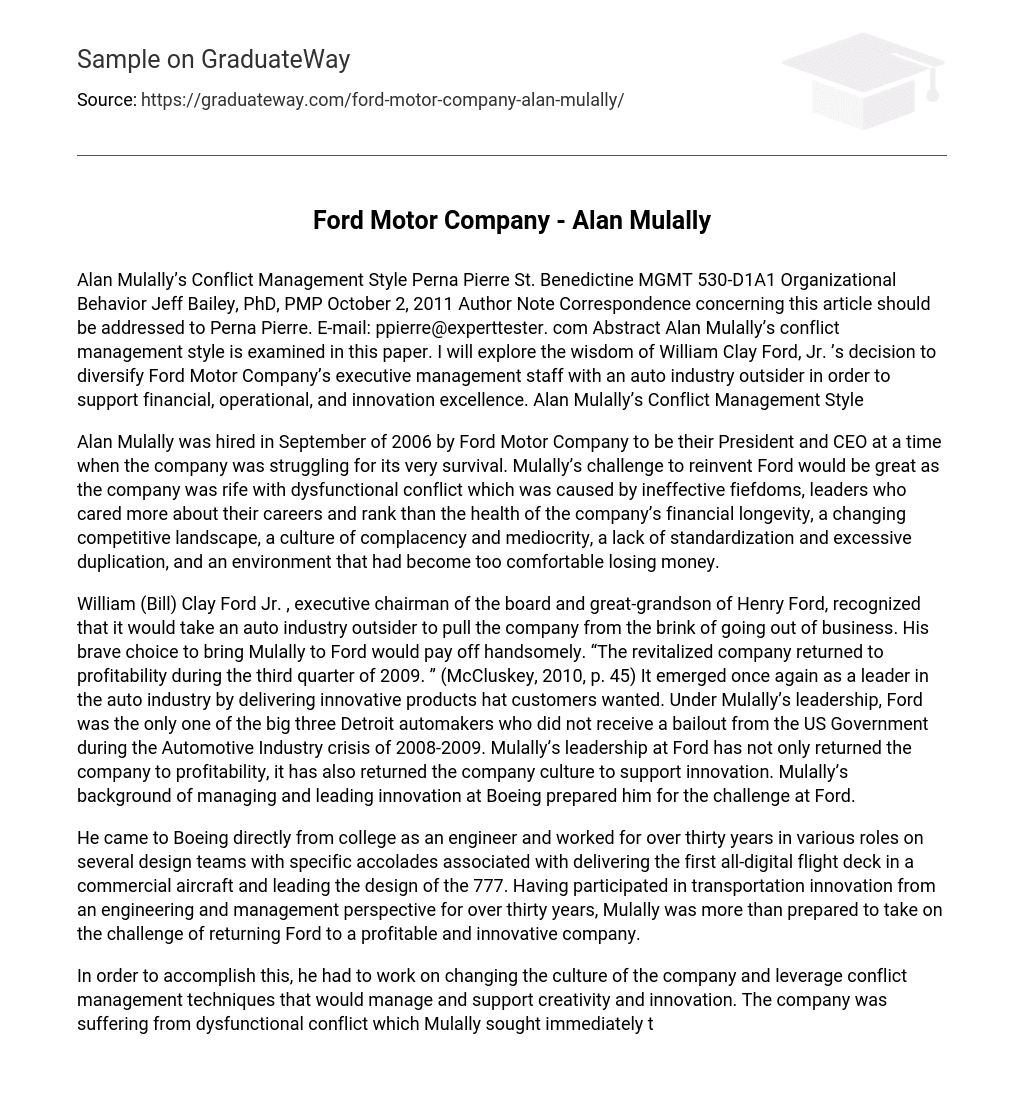Abstract
Alan Mulally’s conflict management style is examined in this paper. I will explore the wisdom of William Clay Ford, Jr. ’s decision to diversify Ford Motor Company’s executive management staff with an auto industry outsider in order to support financial, operational, and innovation excellence.
Alan Mulally’s Conflict Management Style
Alan Mulally was hired in September of 2006 by Ford Motor Company to be their President and CEO at a time when the company was struggling for its very survival. Mulally’s challenge to reinvent Ford would be great as the company was rife with dysfunctional conflict which was caused by ineffective fiefdoms, leaders who cared more about their careers and rank than the health of the company’s financial longevity, a changing competitive landscape, a culture of complacency and mediocrity, a lack of standardization and excessive duplication, and an environment that had become too comfortable losing money.
William (Bill) Clay Ford Jr. , executive chairman of the board and great-grandson of Henry Ford, recognized that it would take an auto industry outsider to pull the company from the brink of going out of business. His brave choice to bring Mulally to Ford would pay off handsomely. “The revitalized company returned to profitability during the third quarter of 2009. ” (McCluskey, 2010, p. 45) It emerged once again as a leader in the auto industry by delivering innovative products hat customers wanted.
Under Mulally’s leadership, Ford was the only one of the big three Detroit automakers who did not receive a bailout from the US Government during the Automotive Industry crisis of 2008-2009. Mulally’s leadership at Ford has not only returned the company to profitability, it has also returned the company culture to support innovation. Mulally’s background of managing and leading innovation at Boeing prepared him for the challenge at Ford.
He came to Boeing directly from college as an engineer and worked for over thirty years in various roles on several design teams with specific accolades associated with delivering the first all-digital flight deck in a commercial aircraft and leading the design of the 777. Having participated in transportation innovation from an engineering and management perspective for over thirty years, Mulally was more than prepared to take on the challenge of returning Ford to a profitable and innovative company.
In order to accomplish this, he had to work on changing the culture of the company and leverage conflict management techniques that would manage and support creativity and innovation. The company was suffering from dysfunctional conflict which Mulally sought immediately to address. As an example of how eloquently he manages conflict, consider his handling of a visit he and two senior engineers made to one of Consumer Reports automobile testing facilities. As the Consumer Report tester was reporting the test results, the engineers got defensive and began explaining design decisions to Mulally.
He immediately recognized that there was a conflict caused by incompatible goals. That is, he had flown to Consumer Reports to get information and test results, not to understand why design decisions were made. Observing this conflict caused him to comment that, “We seek to be understood more than we seek to understand,” (Mulally as cited in Kiley, 2007) In order to get the visit back on track he used a problem solving conflict style to refocus the engineers by suggesting that they just listen to the test results and write down their notes.
While the Business Week article recounting this visit does not tell the final outcome of the visit, it seems obvious that the team could focus on the goal of the visit and Mulally’s intervention would be helpful to ensure that the goals of the visit were met. Mulally’s tenure at Ford has focused on operational and financial excellence. In order to reduce dysfunctional conflict, he encourages a culture that shares information, is safe to admit that you “don’t know”, standardizes where appropriate, eliminates duplication, includes subordinates in privileged executive meetings, and treats white and blue collar workers the same.
His hard work to change the culture is paying off. “Later this year, as the 2012 Ford Focus goes into production, an American car company will be producing a global car—80 percent its parts are the same no matter where it’s built. ” (Johnson, 2010) Mulally’s work has also created some conflicts. Some of the executives he inherited are struggling to find their place in the organization. In order to support constructive conflict management, Bill Ford will not entertain executives that want to complain to him about Mulally. He encourages them to work with Mulally directly to resolve conflicts.
Bill Ford commented that, “If I had even cracked the door open an inch to let anybody complain to me or to think that there was ever any separation between the two of us, I think the culture would have overwhelmed Alan and ultimately brought the company down. ” (“Time Chooses Mulally”, 2010) Bill Ford’s commitment to the long term goal of improving the health of the company is causing him to support a strong team identity; which is the most important indicator that team members will adopt a constructive conflict management style.
Mulally’s appointment as the President and CEO was a risk for Bill Ford to take; given that Mulally had no auto industry experience. His appointment has been a good investment. Since his arrival at Ford, Mulally is returning the company to profitability, supporting a culture that delivers innovative products that customers want, and investing in employee motivation so that they can focus on the long term success of the company. Bill Ford’s analysis of Mulally’s progress is that, “Alan was the right choice [to be CEO], and it gets more right every day,” (Bill Ford as cited in Taylor, 2009)
References
- Kiley, D. (2007). THE NEW HEAT ON FORD. BusinessWeek, (4037), 32-38.
- Johnson, M. (2010). Turnaround Tale. CIO, 23(17), 4.
- McCluskey, E. (2010). Alan Mulally, SM’82. Technology Review, 113(5), M45.
- Glinow, M. (2010). Individual Behavior, Personality, and Values.





